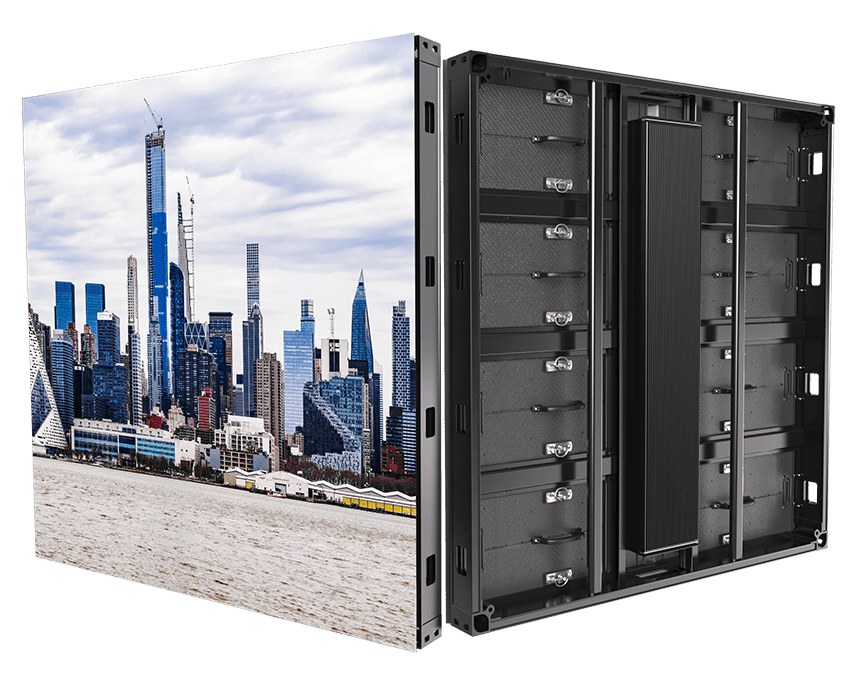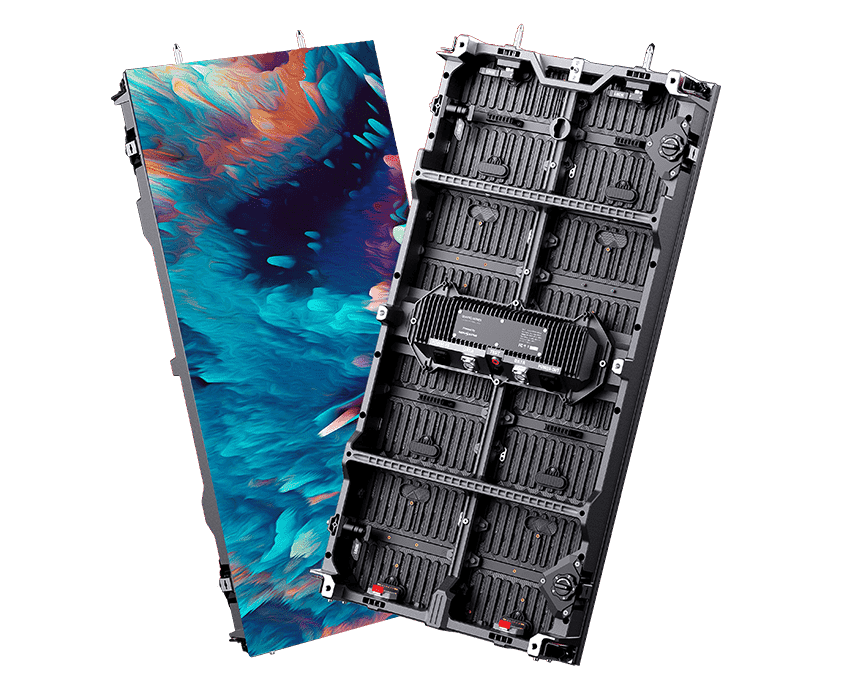UHD and QLED are popular terms in the world of LED displays and TVs. Knowing the differences between these technologies can help you decide which one is best for your commercial or home use. This guide will break down the features, benefits, and unique strengths of UHD and QLED to help you make an informed decision for advertising, events, or home entertainment.
What is UHD?
Ultra High Definition (UHD), also known as 4K, refers to a resolution standard commonly used in modern LED displays and TVs. It has four times the resolution of Full HD (1920 x 1080 pixels), with a typical UHD display boasting a resolution of 3840 x 2160 pixels. This increase in resolution results in sharper images, more detail, and an immersive viewing experience, which is ideal for large-scale advertising displays and home theater systems where clarity and impact are crucial.
Key Features of UHD
-
Resolution: UHD provides a significant improvement over standard Full HD, offering more than 8 million pixels on the screen, which ensures crystal-clear visuals for large audiences or immersive home viewing.
-
Versatility: UHD technology is compatible with most commercial content formats and streaming platforms, making it suitable for digital advertising, events, presentations, and home entertainment.
-
Affordability: UHD displays and TVs are often more affordable compared to newer technologies like QLED, making them a cost-effective solution for businesses and households that require high-quality visuals.
What is QLED?

Quantum Light-Emitting Diode (QLED) technology is a step above traditional LED displays and TVs, utilizing quantum dot technology to improve brightness, color volume, and overall picture quality. QLED displays are developed by companies like Samsung and use a backlit LED panel paired with a layer of quantum dots to produce vibrant colors and enhanced contrast. This makes QLED ideal for commercial applications that require vivid, high-impact visuals, such as outdoor advertising or stage events, as well as premium home entertainment.
Key Features of QLED
-
Quantum Dot Layer: QLED panels include a layer of quantum dots that enhances the display’s ability to produce a broader color spectrum, resulting in better color accuracy and saturation—essential for digital signage, brand advertisements, and home theater experiences.
-
Brightness and HDR: QLED displays and TVs are known for their high brightness levels (often exceeding 1000 nits), making them ideal for environments with high ambient light, such as outdoor advertising or brightly lit living rooms.
-
Energy Efficiency: Despite having high brightness levels, QLEDs are relatively energy-efficient compared to some other high-end display technologies, making them suitable for continuous use in commercial settings and home environments.
Detailed Technical Comparison: UHD vs QLED for LED Displays and TVs
1. Display Technology
UHD is a resolution standard that defines pixel density, typically 4K or 8K, ideal for applications requiring clear detail, like advertising or home viewing. QLED enhances LED panels with quantum dots, improving color and brightness. All QLED displays are UHD, but not all UHD displays are QLED, making QLED more impactful for advertising, events, and entertainment.
2. Color Accuracy and Brightness
UHD provides sharp and detailed images, but QLED, with quantum dot technology, achieves a wider color gamut and enhanced brightness, making it ideal for environments like outdoor advertising, home theaters, and bright rooms where vibrant colors and high brightness are crucial.
3. Backlighting and Contrast
UHD displays use either edge-lit or full-array LED backlighting, with full-array offering better contrast and dimming capabilities compared to edge-lit panels. QLED displays often feature full-array local dimming (FALD), which allows for precise control of backlighting zones, resulting in improved contrast and deeper blacks—essential for high-quality visuals in both commercial and home settings.
4. Viewing Angles and Screen Type
UHD displays use either VA or IPS panels, with VA offering better contrast but narrower angles, while IPS provides wider angles with reduced contrast. QLED displays typically use VA panels but include technologies that enhance viewing angles, making them ideal for larger audiences in public spaces or family
5. HDR Performance
UHD displays may support HDR10 or Dolby Vision, but the HDR quality depends on the display’s brightness and color capabilities. QLED excels in HDR due to higher brightness and quantum dot technology, making it ideal for high dynamic range content in both commercial and home environments.
6. Refresh Rate and Applications
UHD displays typically come with a 60Hz refresh rate, which is suitable for general video playback but may result in motion blur for fast-paced content. QLED displays often offer higher refresh rates (up to 120Hz or more) along with features that reduce motion blur, making them ideal for live broadcasts, sports events, and gaming.
UHD vs QLED: Feature Comparison Overview
| Feature |
UHD Display/TV |
QLED Display/TV |
|
Resolution
|
4K / 8K
|
4K / 8K
|
|
Color Accuracy
|
Standard
|
Enhanced with Quantum Dots
|
|
Brightness
|
Moderate
|
High (often >1000 nits)
|
|
Backlighting
|
Edge-lit or Full-array
|
Full-array with Local Dimming
|
|
HDR Performance
|
Basic to Moderate
|
Excellent (HDR10+, Dolby Vision)
|
|
Viewing Angles
|
Limited (Panel-dependent)
|
Improved with QLED technology
|
|
Refresh Rate
|
60Hz
|
Up to 120Hz or higher
|
Technical Use Cases and Scenarios for Commercial LED Displays and TVs
Outdoor Advertising
For outdoor advertising displays, QLED is often the preferred choice due to its high brightness and enhanced color range. These features ensure that advertisements are visible even in direct sunlight, capturing the attention of passersby.
Event and Stage Displays
In settings such as event stages and concerts, where vibrant visuals are key, QLED displays provide the brightness and color accuracy needed to create immersive experiences. The higher refresh rates also ensure smooth visuals, which is crucial during live events.
Indoor Digital Signage
For indoor digital signage in locations such as shopping malls or corporate offices, UHD displays are a cost-effective solution that provides clear, high-resolution visuals suitable for advertising, wayfinding, or informational displays.
Home Theater Systems
For home use, QLED TVs excel due to their superior brightness, color accuracy, and HDR performance, making them ideal for creating a cinematic experience in your living room. The enhanced color volume makes movies, shows, and sports look vibrant and lifelike.
Gaming Setups
QLED TVs are also ideal for gaming due to their higher refresh rates and variable refresh rate (VRR) features, which reduce motion blur and screen tearing, providing a smooth and immersive gaming experience compared to standard UHD TVs.
Buying Guide for Commercial Displays
| Criteria |
UHD Displays and TVs |
QLED Displays and TVs |
|
Budget
|
Ideal for those on a budget, offering a balance of quality and affordability. Suitable for indoor signage and home use.
|
More expensive, but provide significant improvements in color, brightness, and quality. Best for high-impact advertising, events, or premium home entertainment.
|
|
Bit Depth
|
Generally use 8-bit panels, suitable for most general purposes.
|
Often use 10-bit panels for smoother color transitions and better gradients.
|
|
Panel Type
|
VA panels offer better contrast but narrower angles; IPS panels offer wider viewing angles with lower contrast.
|
Typically use VA panels with technologies to improve viewing angles, suitable for public or family spaces.
|
|
Brightness & HDR
|
Standard brightness and HDR, may struggle in very bright environments.
|
Higher brightness levels and enhanced HDR support, ideal for bright and dynamic environments.
|
Final Thoughts
When choosing between UHD and QLED displays, it's essential to consider your specific needs—whether it's affordability for indoor signage or high-impact visuals for outdoor advertising and events. UHD offers an economical solution with excellent resolution, while QLED excels in brightness, color accuracy, and advanced features that make it the ideal choice for premium experiences. Understanding these differences will help you make an informed choice that aligns with your requirements.
PTCLED is a leading manufacturer of LED displays, and we're here to help you find the right solution for your needs. Whether you're considering UHD or QLED for commercial or home use, contact us today to discuss how we can provide the perfect LED display for your project.
Frequently Asked Questions (FAQ)
1. Is UHD the same as 4K UHD?
A: Yes, UHD and 4K UHD are often used interchangeably. UHD refers to a resolution of 3840 x 2160 pixels, commonly called 4K. True 4K used in cinema is slightly higher at 4096 x 2160 pixels.
2. Is UHD better than OLED?
A: OLED generally provides superior contrast, deeper blacks, and better viewing angles compared to UHD, which focuses primarily on resolution. UHD is more affordable, while OLED offers enhanced picture quality due to its self-emissive pixels, especially for dark scenes.
3. What Are the Key Technical Differences Between UHD and QLED?
A: The key difference lies in the technology: UHD describes the resolution, while QLED refers to an advanced display technology that provides better color accuracy and brightness, especially for high-impact use.
4. Is QLED Worth the Price Over UHD for Commercial Applications?
A: If you value enhanced color accuracy, brightness, and HDR for advertising, events, or premium home use, QLED is worth the investment.
5. How Do Quantum Dots Improve Picture Quality?
Quantum dots in QLED displays allow for greater color volume and higher brightness, resulting in more vibrant and lifelike images, which are essential for commercial and home viewing.



















































































